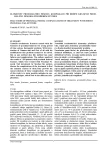A Prospective Comparison of clinical examination RTG, US and CT artrography and Arthroscopy to Detect Rotator Cuff Tears
Authors:
José Decordeiro; Radek Hart; Peter Filan; Václav Štipčák
Authors‘ workplace:
Department of Orthopaedics and Traumatology, General Hospital, Znojmo, Czech Republic
; Ortopedicko-traumatol. odd., Nemocnice Znojmo, MUDr. Jana Janského, Znojmo, ČR
Published in:
Úraz chir. 16., 2008, č.1
Overview
Aim:
The aim of our study was to evaluate the efficiency of X-ray, Ultrasonography (US) and CT arthrography in the diagnosis of the rupture of the rotator cuff.
Methods:
Twenty adult patients with average age of 46,1, who complained of shoulder pain were examined (clinically, X-ray, US, CT arthrography) during a 10-month period, and subsequently underwent arthroscopy of the affected shoulder.
Results:
Using athroscopy as gold standard, both US and CT arthrography showed high diagnostic efficiency to detect tears, with sensitivity, specificity, positive and negative predictive accuracies of 86,7 %, 80 %, 92,9 % and 66,7 % for US, and 93,3 %, 80 %, 93,3 % and 80 % for CT arthrography, 33 %, 100 %, 100 % and 33 % for X-ray, respectively. To evaluate the correlation of the tests with arthroscopy we calculated the Cohen coefficient kappa. This was significant for US (p=0,005), for CT arthrography (p<0,001), the coefficient for X-ray was not relevant.
Conclusion:
The diagnostic ability of US and CT arthrography to detect rotator cuff tears implies that it can be used successfully.
Key words:
shoulder, rotator cuff, Ultrasonography , CT artrography, X-ray.
Sources
1. BACHMANN,G., BAUER,T., JURGENSON, J. et al. Diagnostische Sicherheit,und theraupetische Relevanz von CT - Artrographie und MR - Arthrografie der Schulter. Fortschr Rontgenstr. 1998, 2, 149–156.
2. BAJDOVÁ, I. Ultrasonografie rotátorové manžety ramenního kloubu – technika vyšetření, normální a patologické nálezy. Acta Chir Orthop Traum Čech. 1999, 4, 217–224.
3. BARTONÍČEK, J., DOSKOČIL,M., HEŘT, J., SOSNA, A. Chirurgická anatomie velkých končetinových kloubů. Praha: Avicenum 1991. 249 s.
4. DAVID, M., DANIEL, P., PETR, M. Irreparable Rotátor Cuff Tears: What to do and When to do it, The Surgeons Dilema. J Bone Joint Surg. 2006, 88-A, 2294–2302.
5. DePALMA, A. F., CALLERY, G., BENNET, G.A. Variational anatomy and degerative lesions of the shoulder joint. Instr course lect. 1949, 6, 255–281.
6. DUNGL, P. a kol. Ortopedie.1. vyd., Praha: Grada Publishing, 2005, 1233 s.
7. GUCKEL,C., NIDECKER, A. Diagnosis of tears in rotator-cuff-injuries. Eur J Radiol. 1997, 25 168–176.
8. HART, R., JANEČEK, M., ZELNÍČEK, P., CHAKER A. The floating shoulder treatment of 25 patients. Osteo Trauma Care. 2003, 11 61– 64.
9. LISÝ, M., HREUSÍK, P., ŠTEŇO, B. Tvar akromia a jeho vplyv na subakomiálny priestor. Acta Chir Ortop Traum Čech. 2004, 2 110– 114.
10. PAVLATA, J., BRTKOVÁ, J. Korelace arthroskopického nálezu s UZ vyšetřením ramenního kloubu. Acta Chir Ortop Traum Čech. 1998, 1 47– 51.
11. SAMUEL, R. WARD, P., ERIC, H. Rotator cuff Muscle architecture Implications for glenohumeral Stability. Clinical Orthopaedics and related research, Lippincot Williams Wilkins. 2006, 448, 157– 163.
12. UMANS, H., PAVLOV,H., BERKOWITZ, M. Correlation of radiographic and arthroscopic findings with rotator cuff tears and degenerative joint disease. J Schoulder Elbow Surg. 2001 10, 428– 433.
13. ŽIŽKOVSKÁ, K., KOLAŘ, J., DVOŘÁK, V. CT artrografie ramenního kloubu. Česká Radiologie. 2000, 54, 135–144.
14. WIENER, S.N., SEITZ,W. H. J. Sonography of the shoulder in Patiens with Tlars of the rotator Cuff: Accuracy and Value for Selecting Surgical Options. Amer J Roentgenol. 1993, 160, 103–107.
Labels
Surgery Traumatology Trauma surgeryArticle was published in
Trauma Surgery

2008 Issue 1
Most read in this issue
- Functional results after treatment of radial head fractures
- FRACTURES OF PROXIMAL FEMUR, COMPLICATIONS OF TREATMENT WITH SHORT PROXIMAL NAIL SYNTHES
- A Prospective Comparison of clinical examination RTG, US and CT artrography and Arthroscopy to Detect Rotator Cuff Tears
- Comparison of Reliability of AO/ASIF and Evan’s Classifications
